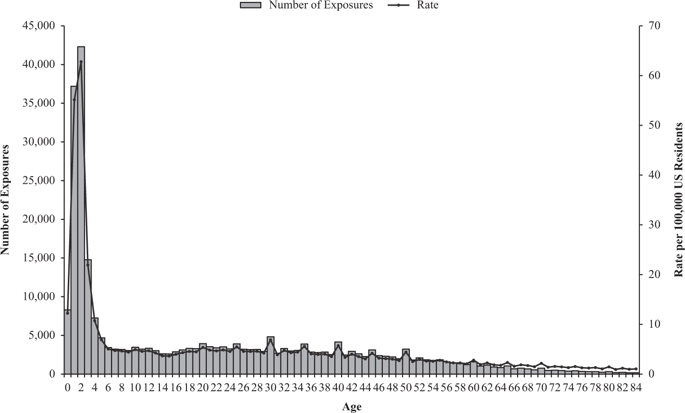Our official English website, www.x-mol.net, welcomes your feedback! (Note: you will need to create a separate account there.)
Household cleaning product-related ocular exposures reported to the United States poison control centres
Eye ( IF 3.9 ) Pub Date : 2019-12-09 , DOI: 10.1038/s41433-019-0691-9 Alisha Kamboj 1, 2 , Henry A Spiller 2, 3 , Marcel J Casavant 1, 2, 3 , Sandhya Kistamgari 1 , Thitphalak Chounthirath 1 , Gary A Smith 1, 2, 4
Eye ( IF 3.9 ) Pub Date : 2019-12-09 , DOI: 10.1038/s41433-019-0691-9 Alisha Kamboj 1, 2 , Henry A Spiller 2, 3 , Marcel J Casavant 1, 2, 3 , Sandhya Kistamgari 1 , Thitphalak Chounthirath 1 , Gary A Smith 1, 2, 4
Affiliation

|
Background/objectivesTo investigate ocular exposures associated with household cleaning products in the United States.Subjects/methodsA retrospective analysis of ocular exposures associated with household cleaning products was conducted using data from the National Poison Data System from 2000 through 2016.ResultsFrom January 2000 through December 2016, poison control centres in the United States received 319,508 calls for household cleaning product-related ocular exposures, averaging 18,795 exposures annually. The annual frequency of exposures decreased significantly by 28.8% during the study period. The rate of exposures per 100,000 US residents was 28.4 among young children (<6 years), 4.8 among older children (6–12 years), 4.2 among teenagers (13–19 years), and 4.2 among adults (≥20 years); children 2 years old had the highest rate of exposure (62.8). Bleaches (25.9%), wall/floor/tile cleaners (13.4%), disinfectants (10.8%), laundry detergents (6.1%), and glass cleaners (5.3%) were the non-miscellaneous product subcategories most commonly associated with ocular exposures. The product subcategories associated with the greatest proportion of major medical outcomes were drain cleaners (1.4%), oven cleaners (1.1%), and automatic dishwasher detergents (0.4%).ConclusionsOn average, the United States poison control centres received approximately two reports of household cleaning product-related ocular exposures every hour during the 17-year study period. Although the annual number and rate of exposures declined during this time, the number of these exposures remains high, especially among young children, underscoring the need for additional prevention efforts. Contrary to the overall trend, ocular exposures to laundry detergent packets have increased significantly and merit special preventive action.
中文翻译:

向美国毒物控制中心报告的与家用清洁产品相关的眼部暴露
背景/目标调查美国与家用清洁产品相关的眼部暴露。主题/方法使用国家毒物数据系统 2000 年至 2016 年的数据对与家用清洁产品相关的眼部暴露进行回顾性分析。结果从 2000 年 1 月至 2016 年 12 月,美国的毒物控制中心接到了 319,508 次家庭清洁产品相关眼部暴露的电话,平均每年 18,795 次暴露。在研究期间,每年的暴露频率显着下降了 28.8%。每 100,000 名美国居民的暴露率为幼儿(<6 岁)28.4,年龄较大的儿童(6-12 岁)为 4.8,青少年(13-19 岁)为 4.2,成人(≥20 岁)为 4.2;2 岁儿童的接触率最高 (62.8)。漂白剂 (25.9%)、墙壁/地板/瓷砖清洁剂 (13.4%)、消毒剂 (10.8%)、洗衣粉 (6.1%) 和玻璃清洁剂 (5.3%) 是最常与眼睛接触相关的非杂项产品子类别. 与主要医疗结果比例最大的产品子类别是排水管清洁剂 (1.4%)、烤箱清洁剂 (1.1%) 和自动洗碗机清洁剂 (0.4%)。结论平均而言,美国毒物控制中心收到了大约两份报告在 17 年的研究期间,每小时与家庭清洁产品相关的眼部暴露。尽管在此期间每年接触的数量和比率有所下降,但这些接触的数量仍然很高,尤其是在幼儿中,强调需要进行额外的预防工作。与总体趋势相反,洗衣粉包的眼睛暴露量显着增加,值得采取特殊的预防措施。
更新日期:2019-12-09
中文翻译:

向美国毒物控制中心报告的与家用清洁产品相关的眼部暴露
背景/目标调查美国与家用清洁产品相关的眼部暴露。主题/方法使用国家毒物数据系统 2000 年至 2016 年的数据对与家用清洁产品相关的眼部暴露进行回顾性分析。结果从 2000 年 1 月至 2016 年 12 月,美国的毒物控制中心接到了 319,508 次家庭清洁产品相关眼部暴露的电话,平均每年 18,795 次暴露。在研究期间,每年的暴露频率显着下降了 28.8%。每 100,000 名美国居民的暴露率为幼儿(<6 岁)28.4,年龄较大的儿童(6-12 岁)为 4.8,青少年(13-19 岁)为 4.2,成人(≥20 岁)为 4.2;2 岁儿童的接触率最高 (62.8)。漂白剂 (25.9%)、墙壁/地板/瓷砖清洁剂 (13.4%)、消毒剂 (10.8%)、洗衣粉 (6.1%) 和玻璃清洁剂 (5.3%) 是最常与眼睛接触相关的非杂项产品子类别. 与主要医疗结果比例最大的产品子类别是排水管清洁剂 (1.4%)、烤箱清洁剂 (1.1%) 和自动洗碗机清洁剂 (0.4%)。结论平均而言,美国毒物控制中心收到了大约两份报告在 17 年的研究期间,每小时与家庭清洁产品相关的眼部暴露。尽管在此期间每年接触的数量和比率有所下降,但这些接触的数量仍然很高,尤其是在幼儿中,强调需要进行额外的预防工作。与总体趋势相反,洗衣粉包的眼睛暴露量显着增加,值得采取特殊的预防措施。



























 京公网安备 11010802027423号
京公网安备 11010802027423号